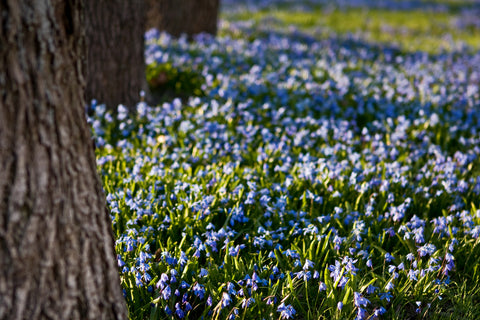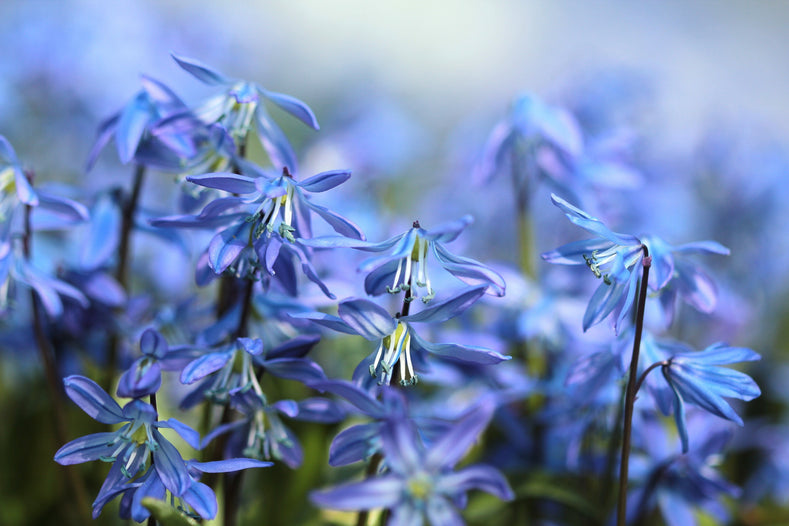Siberian Squill (Scilla Siberica)
Tulips, narcissi, hyacinths, snowdrops…. there are so many beautiful flower bulbs, and they all have their own charm and characteristics. In this blog series we would like to introduce you to a variety of them, helping you to make the best choices for your garden and grow the spring display of your dreams!
Sky-Blue (Semi) Siberian
A distant cousin of the asparagus, Siberian Squill is one of the first flower bulbs to come up after the winter. This compact plant has beautiful sky-blue blooms that are star or bell-shaped, nodding and drooping on short stems. Every plant has three to five stems, so you’ll get plenty of blooms. In spite of its name, Scilla Siberica is not native to Siberia, but probably got its name because it’s so incredibly hardy, thriving as far north as USDA hardiness zone 2.

Plant Passport
- Height
Siberian Squill will grow up to 6 inches in height.
- Fragrance
Scilla Siberica is one of spring’s first fragrant flowers, making it the ideal plant for a tiny bouquet lending a tender aroma to the smaller spaces in your home like your bedroom or bathroom.
- Color
A brilliant blue reminiscent of glorious spring skies and ice-cold mountain lakes.
- Bloom time
The bloom time of Siberian Squill depends on the weather, but generally Scilla blooms in early spring, March to April. This flower bulb is a hardy little fellow and can bloom through frost and even small layers of snow.
- Longevity
Scilla is a perennial flower bulb so it comes back every year. On top of that, it’s one of the most prolific naturalizers in bulb land. Once the flowers fade, the plant produces seeds that take root where they land.
- Planting
Like all bulbs, Scilla grows best in well-draining soil, because standing in water for too long might lead the bulbs and roots to rot. Choose a place that gets full sun in the morning and a bit more shade in the afternoon. When fall arrives, plant the bulbs with their pointy end up in holes that are 5 inches deep, 2-4 inches apart. If you want to make sure that Siberian Squill gives you the best it has, it might be helpful to improve the soil by working in a 2-inch layer of compost before you plant the bulbs.
- Forcing
To get the thrill of Squill all year ‘round, you can force the plant by placing the bulbs in a cold place (between 35-45 F) for 10-12 weeks. This is called prechilling and many people use the vegetable drawer of their fridge or their unheated garage for this. After the bulbs have prechilled you can force them in either water or soil. For forcing in water, you can buy special vases that allow the bulb to sit with only its roots in the water, or you just use a bowl filled with pebbles. Bury the bulbs halfway in the pebbles with the points facing up, then fill the bowl with water so the lower quarter of the bulb is in the water. For soil forcing you fill the pot with a light potting mix (not with soil from your own garden!). Plant the bulbs three-quarters of the way deep into the pot, but make sure the pointy tops stick out of the soil. Water the bulbs and keep the soil moist. After planting, keep your bulbs in a cool (50-60 F) place for a week. Once leaves appear, move them to a warmer place, making sure the roots always have moisture. To really get the best out of your forced Squill, make sure to place them in bright, indirect light.
- Container Planting
Pick a well-draining pot or planter, filling it with loose, rich soil. Plant the bulbs about 4 inches deep, and water them well. Since Scilla is deer resistant, you can place the containers anywhere in your garden, but these early visitors will also be a wonderful spring-surprise on your rooftop deck or window sill.
- Pricing
Like most very early bloomers, Siberian Squill is great for carpet planting. And you’re in luck, because DutchGrown is all about high quality large quantities at the best prices. You can try out Scilla with 25 bulbs at $0.28 each, but why not go the full hog and get 50% off with 1000 bulbs for $0.14 a bulb?
- Combinations
Scilla Siberica’s springtime blue color goes very well with its white sister Scilla Tubergeniana, but it also looks great together with Chionodoxa, which flowers a bit earlier. It overlaps with Galanthus and even stays around to greet the earliest Daffodils!
Get your Squill on
A springtime garden full of these enthusiastic little bulbs can be yours at the click of a mouse! Go to our website and order Scilla now, and DutchGrown will make sure they’re delivered at your door at the perfect planting time.

